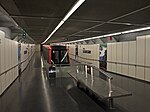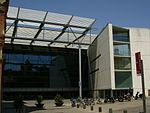Avinguda del Paral·lel

Avinguda del Paral·lel (Catalan pronunciation: [əβiŋˈɡuðə ðəl pəɾəˈlːɛl]; English: Avenue of the Parallel) is one of the main streets of the city of Barcelona, dividing Ciutat Vella, Eixample and Sants-Montjuïc districts. It receives this name because it is (unlike any other street in Barcelona) parallel to the Equator (at 41°22′30″ North). It runs from Plaça d'Espanya, where the city's exhibition halls are located, to the seafront, Plaça de la Carbonera and the passenger ship port, dividing the neighbourhood of Poble Sec, on the side of Montjuïc, from the neighbourhoods of Sant Antoni and El Raval. It was officially inaugurated on October 11, 1894.El Paral·lel, as the avenue and sometimes the surrounding quarter are called, is most known for theatres (as of 2009, there are three in the avenue, Apolo, Condal and Victoria, but there were many more), as well as cabarets and erotic shows, or the Sala Apolo. In the past it was the core of Barcelona's nightlife, with music halls and other venues, but in the last two decades its importance has diminished greatly, in favour of the city centre and Eixample, and some urban decay is visible. El Molino, once one of the city's most renowned cabarets, is being rebuilt.
Excerpt from the Wikipedia article Avinguda del Paral·lel (License: CC BY-SA 3.0, Authors, Images).Avinguda del Paral·lel
Avinguda del Paral·lel, Barcelona
Geographical coordinates (GPS) Address Nearby Places Show on map
Geographical coordinates (GPS)
| Latitude | Longitude |
|---|---|
| N 41.374966666667 ° | E 2.1630527777778 ° |
Address
Avinguda del Paral·lel 111
08001 Barcelona
Catalonia, Spain
Open on Google Maps










